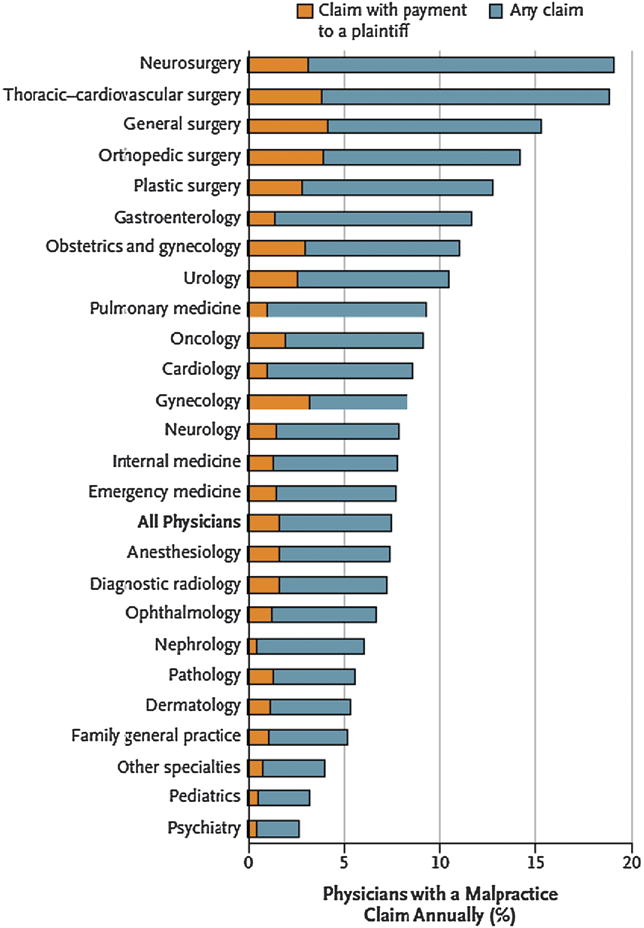
Author: Chi, John H.
Source: Neurosurgery. 2011 Dec;69(6):N18-20.
The author states
that: "Dealing with malpractice lawsuits is no doubt one of the most
challenging and unpleasant aspects of our jobs as physicians and
surgeons. The shifting public opinion of the medical profession, lack
of education and instruction on how to avoid and handle malpractice
suits, and the general lack of reform in malpractice law make the
situation more difficult and frustrating. Current data on malpractice
rates and risk is difficult to ascertain from professional
organizations due to reporting biases, as well as from government
databases, which tend to only include cases leading to actual indemnity
payments.
Using actual data from a single large
national professional liability insurer, Chandra and colleagues (N Engl
J Med. 2011;365(7):629-636) determined the rate and risk of being sued
in over 25 specialties and the breadth and depth to which any of these
suits resulting in indemnity payments (any monies paid to plaintiff).
Insurance data from 1991 to 2005 included 40 916 physicians ranging
over 25 specialties in both high and low risk specialties, with all 50
states and the District of Columbia being represented.
Specialty-specific claim and payment rates were calculated and adjusted
risk rates determined.
For each year in the study, a
rate of 7.4% of physicians was sued with only 1.6% of those physicians
having to make a payment to the plaintiff. An overwhelming 78% of all
claims did not result in payments to the plaintiff, but obviously all
claims incurred cost for defense of the suit.
The highest
proportion of physicians facing a claim was neurosurgery at 19.1%,
followed by cardiothoracic surgery (18.9%) and general surgery (15.3%).
The lowest proportions were in family medicine (5.2%), pediatrics
(3.1%) and psychiatry (2.6%). Indemnity payments varied by specialty,
with neurosurgery-related indemnity payments ranking 4th with an
average of $344 811. For high risk specialties such as neurosurgery,
88% of physicians were likely to be sued by age 45, with that number
rising to 99% by age 65.
Despite the advances in the
field of neurosurgery over the past several decades, neurosurgery tops
the list of specialties with malpractice claims made against it.
Despite the overall low rate of being successfully sued, average
payouts for neurosurgeons still tend to be high. As a recognized
high-risk profession, steps to try and avoid malpractice suits would
include practicing defensive medicine and avoiding complicated cases.
These measures can be, however, counter to one of the missions of our
profession, which is to provide the highest level of care that is best
for our patients. As healthcare policy and medical training evolve
around us, incorporating this information on rates and risk of
malpractice claims should impact how we prepare ourselves for the
future to avoid and minimize malpractice suits altogether".

Link for the
abstract: http://www.ncbi.nlm.nih.gov/pubmed/22067347
Any comment about this page?
Your feedback is appreciated. Please click
here.
To join Scientific Spine mailing list, click here.
You are here: Scientific Spine > Spine Articles > Spine Excerpts > Neurosurgery tops malpractice risk